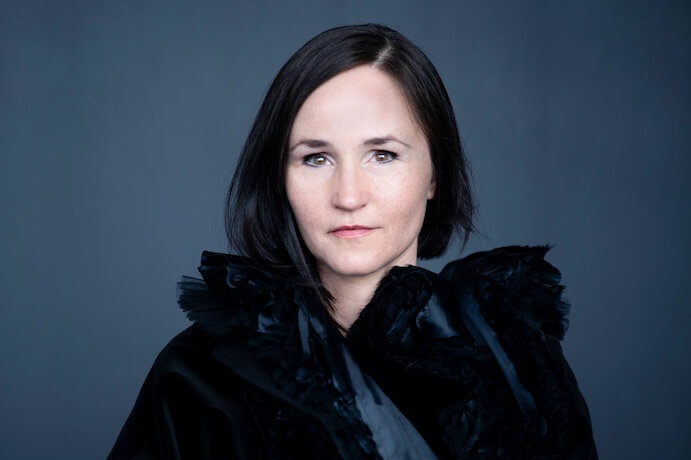Icelandic composer Anna Thorvaldsdottir creates music with immersive and dreamlike qualities. In orchestral and chamber works alike, she ushers listeners through endless corridors and starkly resonant chambers of her imagination. With two albums and several big premieres this season, both fans and newcomers to Anna’s music have a lot to celebrate. If you don’t know her music well, the recently released album Atmospheriques (2023 Sono Luminus), recorded by the Iceland Symphony Orchestra led by Daníel Bjarnason, is a fantastic starting point. Her major orchestra work CATAMORPHOSIS (2022) features lush orchestrations that form the bedrock of a living, breathing sound world where fluid timbres swell and recede around monolithic melodic material. Anna’s music is easily accessible yet intricately crafted — a combination that is sure to inspire repeated listens.
Just a month after the release of Atmospheriques, Sono Luminus released ARCHORA/AIŌN (May 26), also recorded by the Iceland Symphony Orchestra, this time led by chief conductor Eva Ollikainen. With the addition of these two albums, Sono Luminus has released all six of Anna’s orchestral works to date.
If you are in England this summer, you have the chance to catch Anna’s orchestral works live in concert at the Royal Opera House in London (June 9-17) and at the Aldeburgh Festival in Suffolk (June 12-24). This past May, in New York, the latest installment of legendary flutist Claire Chase’s Density 2036 series featured Anna’s concert-length work Ubique for solo flutes, two cellos, and piano. Anna is a composer in residence at the 2023 Tanglewood Festival (July 28-Aug. 2), which will feature a portrait concert, a performance of METACOSMOS, and the Danish String Quartet performing Rituals.

The sonic and emotional landscapes in your work CATAMORPHOSIS (2022) remind me so much of the novel Piranesi by Susanna Clarke, in which the titular character lives in a mysterious and endless labyrinth that is periodically submerged in the rising ocean tide. Do you draw inspiration from literature, visual art, or other media in your compositions?
That sounds really fascinating. Experiencing the art of others can of course sometimes play a part in opening up certain creative channels, and there are artists whose work particularly resonates with me, but I do not seek active inspiration in the art of others. Inspiration is often quite subconscious, so it can sometimes be hard to determine everything that is going on with it; I like to keep it on that level, actually, so as to allow for a certain amount of magic to it — although reflecting on inspiration can sometimes also allow for creative insights. For me, the more active inspiration is often connected to energy and flow and structure, sometimes in reference to nature, but also to the human aspect and life in general. But whatever I am inspired by each time, it is because I find things in it that are musically interesting.
Much of the drama and beauty in your music comes from your use of timbre and layered soundscapes. What initially drew you to these elements, and what keeps you coming back?
I have always been fascinated with sound materials, effects, and textures in combination with harmonies and lyricism. This comes primarily from how I hear the music internally as I’m working on it, and it is a very organic element to my music. I don’t actively sit down and think about the music in these terms; this is what pours out of me when I am making music and what naturally emerges. So, I probably keep coming back to that simply because it is how I naturally experience the music that I am making.
The process of orchestrating of course plays a really big part in communicating these sounds, textures, and nuances that together create the layers in the overall soundscape. I really enjoy working with these materials to create a natural flow in the music that continuously connects and comes apart throughout the process of a piece. A big part of that is to find organic ways to connect materials that are seemingly very different in nature, but that move between them almost quite seamlessly.

Your music also has an organic and natural sense of structure, which gives it a strong dreamlike quality. Can you tell us a bit about how you conceptualize structure or narrative in your works?
At the earliest stages of working on music, when I am conceiving a new piece and exploring ideas and materials, I need a lot of headspace to dream about the music, to find what it is that the piece wants and needs to become. A lot of this process is about selecting the right ideas for the project each time, and realizing what belongs and what doesn’t. The structure for the piece emerges at the initial stages and really materializes at that point. This process happens through internally listening to the music that I am creating, and that actually continues throughout the entire composition process where the sounds circle in my head over and over again and brew until I find the right balance for all of them.
I am quite obsessed with structure and the journey or “narrative” of the music; I need to know where the music is going and where it is coming from. This process also involves sketching the ideas that I have for the piece, which is a mnemonic device to remember the music. Then, when I really know the music, that is when I start to notate it on paper. At that point, I orchestrate the sounds and nuances and the overall music materials. Also, throughout the entire process, I give myself good space to live with the music in real time over and over again, to let the whole piece resonate internally from beginning to end, to finalize the structure and all the materials within it.
It is of course a bit difficult to describe how the music and its structure and narrative are conceptualized, because it is not a verbal process — it comes from a musical feeling that lives and breathes within, and you have to allow it to emerge. For me, that is also a key part: to allow the music and ideas to emerge rather than to force them to come. A lot of the process is also not being afraid to delete things when something does not fit or belong — even if I have been working on something for a while, and then realize that it doesn’t belong and that it’s fine (and necessary) to let it go.

You’ve written six orchestral works, which have now all been released on the Sono Luminus label. Has your approach to writing for orchestra evolved much from your first work Dreaming (2008) to your most recent ARCHORA (2022)?
In addition to the six orchestral works that I include in my current catalogue, I have also written three earlier pieces. I wrote my first orchestra piece in 2000 and 2001, before I started to study composition, entirely out of passion, and for myself to practice. I really have such a passion for working on pieces for larger forces, and this comes from the way I hear music internally and all the layers within it — the orchestra is such an amazing force for that.
Regarding my own development, it is difficult to analyze your own progress, but I don’t think that my approach to writing orchestral music as such has changed — at least that’s how it feels to me. I approach every piece from a new start, a fresh perspective each time. But of course I hope that I will continue to grow for as long as I live, and there is so much music within me still to be written.
With two album releases and countless big performances, this has undoubtedly been a huge season for you. What projects are you currently working on? What should we keep an eye out for on the horizon?
I am incredibly grateful for how fortunate I have been with performances of my music — it is certainly not something I take for granted. And it is so wonderful to work with all these amazing people. At the moment, I am working on an orchestral installation for an open space: not for a concert hall, but for ‘deconstructed orchestra’ in an open space/foyer, which will be premiered next year. We will share some more news about that soon. I am also starting to work on a cello concerto, which I am really excited about, as well, and we will also share some more information about that soon! Then, there are a number of other works on the horizon in the coming years, including a symphony.
I CARE IF YOU LISTEN is an editorially-independent program of the American Composers Forum, and is made possible thanks to generous donor and institutional support. Opinions expressed are solely those of the author and may not represent the views of ICIYL or ACF.
You can support the work of ICIYL with a tax-deductible gift to ACF. For more on ACF, visit the “At ACF” section or composersforum.org.
























